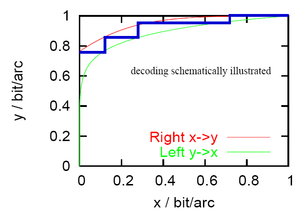
EXIT chart
Encyclopedia

Low-density parity-check code
In information theory, a low-density parity-check code is a linear error correcting code, a method of transmitting a message over a noisy transmission channel, and is constructed using a sparse bipartite graph...
and Turbo code
Turbo code
In information theory, turbo codes are a class of high-performance forward error correction codes developed in 1993, which were the first practical codes to closely approach the channel capacity, a theoretical maximum for the code rate at which reliable communication is still possible given a...
s).
EXIT charts were developed by Stephan ten Brink, building on the concept of extrinsic information developed in the Turbo coding community. An EXIT chart includes the response of elements of decoder (for example a convolutional decoder of a Turbo code, the LDPC parity-check nodes or the LDPC variable nodes). The response can either be seen as extrinsic information or a representation of the messages in belief propagation
Belief propagation
Belief propagation is a message passing algorithm for performing inference on graphical models, such as Bayesian networks and Markov random fields. It calculates the marginal distribution for each unobserved node, conditional on any observed nodes...
.
If there are two components which exchange messages, the behaviour of the decoder can be plotted on a two-dimensional chart. One component is plotted with its input on the horizontal axis and its output on the vertical axis. The other component is plotted with its input on the vertical axis and its output on the horizontal axis. The decoding path followed is found by stepping between the two curves. For a successful decoding, there must be a clear swath between the curves so that iterative decoding can proceed from 0 bits of extrinsic information to 1 bit of extrinsic information.
A key assumption is that the messages to and from an element of the decoder can be described by a single number, the extrinsic information. This is true when decoding codes from a binary erasure channel
Binary erasure channel
A binary erasure channel is a common communications channel model used in coding theory and information theory. In this model, a transmitter sends a bit , and the receiver either receives the bit or it receives a message that the bit was not received...
but otherwise the messages are often samples from a Gaussian distribution with the correct extrinsic information. The other key assumption is that the messages are independent (equivalent to an infinite block-size code without local structure between the components)
To make an optimal code, the two transfer curves need to lie close to each other. This observation is supported by the theoretical result that for capacity to be reached for a code over a binary-erasure channel there must be no area between the curves and also by the insight that a large number of iterations are required for information to be spread throughout all bits of a code.

